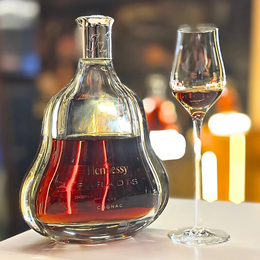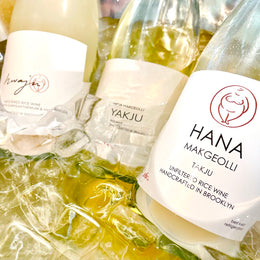Hamada Syuzou Wants To Reimagine Japan's 500 Year Old National Spirit; Taste Testing The Iconic Daiyame 25 & Daiyame 40, Chill Green Spicy & Citrus, Chill Green Bitter & Tropical

Japan's national spirit has been quietly staging a comeback for the ages - shochu with its intense aromatics, clean taste and rich body, is fast gaining ground and popularity with an audience that is beginning to shy away from over the top or fuller bodied drinks. shochu is refreshing, delicate, and elegant - so why haven't we seen it more publicly? As far as Japanese sensibilities go, traditional producers tend to eschew big billboards, product placements in mainstream media, or flashy celebrity endorsements. They very much prefer to let their work do the talking, and so any revolution will have to come one izakaya at a time, glass by glass, paired with savoury grilled meats or comforting broths - that's how shochu envisages itself being enjoyed, and as they say there's a time and place for everything. And so you'd be hard pressed to see in-your-face activations at supermarkets, but instead pull out a menu at your local Japanese eating spot and you'll readily find shochu.
It wants to be seen in a particularly light, and if you know where to look - well then, welcome to the revival.


What is fairly surprising for its place as a national spirit that's core to Japanese heritage - a country proud of its quality, provenance and artistry - is that the shochu category is incredibly broad. It can be made with over 50 different base ingredients ranging from sweet potatoes (Imo shochu), barley (Mugi shochu), rice (Kome shochu), buckwheat (Soba shochu), to even perilla leaves (Shiso shochu) and Japanese black sugar (Kokuto shochu). All you have to do is choose your strain of yeast and koji, allow the base material to ferment, and then distill it in a pot still once - make sure there's no additives added to the shochu and you've now got Honkaku shochu (or authentic shochu)! As you can see shochu is really more a matter of process, or how it's made, as opposed to what it is made from.

This all becomes incredibly interesting when you consider therefore the staggering number of variations of shochu's that can be made. Beyond the over 50 different base materials to choose from, shochu makers can also express themselves through their selection of any type of yeast, and at least three types of koji (a fermented starter that typically comes in black, white or yellow, each imparting a different flavour), as well as how it is distilled and the choice of aging the shochu to varying maturities, and in what sort of vessel. There exists essentially an infinite number of varieties to explore, even as particular styles of shochu have taken the lead in popularity, such as Imo shochu (sweet potato) and Mugi shochu (barley). Taking a step back, this all makes sense when you put into perspective how diverse and distinct one Japanese prefecture is to the next - and quickly you begin to appreciate just why shochu is Japan's national spirit. shochu is as proud of its craftsmanship as it is all encompassing of the multitudes that Japan offers!

Now going right to the heart of shochu country, we find Hamada Syuzou, a foremost producer of shochu in Japan's southern Kagoshima Prefecture, that has operated for over 150 years, having been established in the very year of the Meiji Restoration of 1868 that birthed modern Japan as we know it today.
Based in Ichikikushikino City, the renowned shochu distillery is today led by fifth-generation Yuichiro Hamada, and spans three distinct distilleries, each charged with a sole focus that is a pillar of what Hamada Syuzou considers to be its essence.

The Denbeegura Distillery is focused on preserving and protecting the tradition of producing Honkaku shochu. The Denbeegura distillery was the very origins of Hamada Syuzou in its founding in 1868, and thus ensures that shochu is made in the very same way as it has been for over 150 years - handmade, fermentation in tradition jars, distillation in a wooden pot still, with the use of a koji mold chamber, and with ingredients sourced from only within the Kagoshima locality.

Next is the Kinzangura Distillery, which is perhaps the most striking - it is located in a 120-kilometer former gold mine that was dug 350 years ago, where it was once the source of the prefecture's prosperity. Today it is overseen by an all-female staff of master distillers whose goal is to produce pre-Meiji era Honkaku shochu that was determined to be best aged in the mines which allows for constant temperature throughout the year to ensure even ageing. Make no mistake - this isn't just a storage cellar, the entire process of making the shochu is done inside the mines, from fermentation to distillation, and then ageing. Similar to the Denbeegura Distillery, traditional practices are upheld here with the fermentation and ageing done in earthen jars, while distillation is done with in the historic Edo period helmet kettle process. Here you can even see remnants of the distillery's past as a gold mine, with even a railway passing through the mines.

And then last but not least we have the Denzouingura Distillery, where the primary goal is innovation. Here the distillers endeavour to find new possibilities with shochu-making, and thus look into every aspect from developing its base ingredients to fermentation techniques, and even bottling and shipping. Denzouingura is decked out to the nines when it comes to advanced equipment and facilities - it singlehandedly operates the largest shochu storehouse in Japan, and makes use of computerisation to pin down every aspect of expertise that their master distillers possess to ensure that consistency is perfected and executed every single time.
And today, it is at Denzouingura Distillery that we find ourselves, where we'll take a closer look at how Hamada Syuzou thinks about the next 150 years.

Fifth-generation Yuichiro Hamada.
Whilst Hamada Syuzou has long produced numerous well-known shochu labels in its time, it was on the eve of its 150th anniversary in 2018 that it was thus decided that the Denzouingura Distillery, known for pursuing innovative new styles of shochu, would be tasked to create a new expression celebrating the major milestone - that in itself speaks volumes as to how Hamada Syuzou sees itself into the future.
The result was Daiyame.
The name "Daiyame" is firstly taken to mean "a refresher after a hard day" as is colloquially said in the local Kagoshima dialect, and to that end the team had envisaged producing an expression that would be so stunning that it would cheer anyone up. They had thus set out to create an aroma that was entirely unique, and had not been achieved before - they had noted that sweet potatoes had the ability to express an elusive tropical lychee aroma, and yet this was typically suppressed as it was hard to express and only very little of it could be coaxed out, certainly insufficient to be seen as something positive. With not a single recipe or research that touched on the topic, the team at Denzouingura had thus set about researching how they could concentrate and isolate this rare lychee aroma from local sweet potatoes. After much experimenting, they would thus develop a proprietary ageing process for their sweet potatoes, producing what is know as Kojuku-imo, an aroma enhanced aged sweet potato. And this was just the start of the effort to create the one of a kind Daiyame!

From sweet potatoes to lychees is the modern equivalent of water to wine!
The team would also study the fermentation and distillation process, and thus conclude that only black koji used for fermentation and a special vacuum distillation method would make it possible to produce those tropical lychee flavours. The distillation process was found to be incredible difficult when it came to producing a sweet potato Imo shochu, and yet it was additionally necessary to keep the range of spirit extracted from it within a really strict and narrow range. Having prototyped over 100 samples, the team had finally found what they were looking for.
It's been 7 years now since the Daiyame shochu was launched in 2018, and today it is one of the most iconic shochu's in the market - with intense and vibrant lychee aromas, a fresh and rich body, along with a clean taste and seamless finish, Daiyame has become the golden child of the shochu world. Since then, a higher 40% ABV proof version of the first Daiyame (which is bottled at 25% ABV) has been added to the range, with Daiyame becoming a flagship expression of Hamada Syuzou.

But why stop there? Emboldened by the incredible reception to this new form of shochu, Hamada Syuzou has pressed on with its reimagining of shochu. In 2023, Hamada Syuzou's Denzouingura Distillery has debut a completely new category of shochu - the botanical shochu. Whilst it's long been the gold standard for shochu makers to produce Honkaku shochu - that is authentic shochu with no additives - Hamada Syuzou wants to challenge that notion by distilling its shochu along with a curated palette of botanicals. And so whilst there's been nothing added to the shochu after distillation, this new style sees to it that new flavours are created by means of co-fermentation.
This new process is called "Botani-cohol" by Hamada Syuzou, and operates by way of combining the botanicals selected with the moromi mash where the barley and white barley koji ferments - and so they all fermented together, allowing for the aromatics of the botanicals to infuse the mash and thus be expressed in the final distilled shochu.

The first expression of the new Chill Green botanical shochu series (so named for the distillery's desire for folks to be relaxed, whilst also paying homage to the use of botanicals) was the Chill Green Spicy & Citrus, which focused on the use of Maqaw, a citrusy spice that is similar to sansho peppers. The Maqaw botanical thus allowed the otherwise umami barley shochu (Mugi shochu) to take on a unique spiced and citrusy aroma. In 2025, it was further announced that a second Chill Green Mugi shochu would be named Chill Green Bitter & Tropical, which would see the use of the craft beer cult-favourite Galaxy hop flowers (beers are made through the use of hop flowers that give the beers its classic bitterness, with flavours from citrus to coconuts also produced depending on the hop varietal selected) that was thus co-fermented with the barley, producing a final shochu expression that carried through the iconic Galaxy passionfruit and citrus tropical zestiness, along with the classic beer hops bitterness.

And so with all that said, today we'll be trying a range of Hamada Syuzou's most innovative and out of this world shochus - welcome to Hamada Syuzou's shochu world reimagined.
Let's go!
Shochu Review: Daiyame 25 Imo Shochu (Sweet Potato), 25% ABV

Tasting Notes
Colour: Colourless.
Aroma: Incredibly bright with rich florals and sweet-smelling notes. Opens with lychees and rose petal notes that burst forth – think fresh lychees in rose water. There's a remarkable depth and definition, like you're almost smelling actual lychee and rose essences. It's also really clean despite being so fruity and floral and you'd imagine perfumed – there’s nothing sticky, cloying or artificial about it.
I should point out, while the scent gives the impression of sweet fruit, when you really pay attention to it, it’s more fragrance than pure sugar - it smells like lychees do, not like lychee candy.
Taste: That first sip catches you off guard. You’d expect something sweet or fruity following on from that vibrant nose, but the taste is mellow, restrained and comfortable - not sweet or cloying in the least. There’s a very soft creaminess to the texture with a light touch of sweetness. It reminds me of a crisp perfumed sake - slightly creamy, smooth and soft, but not rich and cloying. There’s also a faint crisp mineral edge to it, almost like a light Chablis -subtle, clean, and very well-integrated.
Finish: Moderate length, crisp and clean. And this is where the minerality peeks through most clearly. There’s a bit of a sweet citrus tone of mikan oranges or even a squeeze of sudachi (a Japanese lime), though it's neither not acidic or sharp, just a little lift of citrus.

My Thoughts
This is a remarkable shochu. The lychee and rose notes that the brand promises are front and center, but in the best possible way: vibrant, elegant and natural. They come through so prominently it's hard to believe until you taste it yourself.
It's got a fascinating contrast otherwise: the nose is fragrant, floral and expressive, the palate is creamy and restrained, and the finish is clean and adds a touch of citrus and minerality. That balance makes it incredibly food-friendly and easy to drink over the course of a meal.
Daiyame doesn't try to be flashy – it’s just unlike anything else, and it’s really, surprisingly good.
Shochu Review: Daiyame 40 Imo Shochu (Sweet Potato), 40% ABV

Tasting Notes
Colour: Colourless but with slower legs.
Aroma: Bright and intensely perfumed right from the start, it opens almost identically to the Daiyame 25—with fresh lychees and rose water—but from here on out, everything feels dialled up a notch. The lychee note now leans into something closer to lychee cream cake, layered with soft florals like rose petals and a definite note of lavender. There’s even a whiff of muscat grapes that gives the aroma a rounder, juicier feel. It’s still very natural and clean, with nothing feeling artificial. A light creaminess carries through, and there’s a faint minty herbaceous edge that brings some lift and freshness.
Taste:The texture is the first thing I noticed. It's very velvety and plush, noticeably thicker than the Daiyame 25. Flavours pick up where the nose left off: lavender, rose, mint with a mellow growing creamy sweetness at the centre. There’s more body here, and the flavours develop gradually to show more and more depth. The lychee cream cake note is yet more prominent now, with a warmth that expands across the palate. There’s also a sort of fresh linen character that brings a bit of clean earthiness. Minerality is present but tucked behind the sweeter floral and creamy notes.
Finish: Quite long. Sweet lavender tea that just keeps going. It holds onto that warmth that builds slightly but never feels aggressive, and the flavours stay complex and layered the whole way through. It's persistent but not heavy.

My Thoughts
This distinctly reminds me of lavender lychee macarons! It’s very floral, very aromatic, more intense and layered than the Daiyame 25. Where the Daiyame 25 gives you bright, fresh lychees, the 40 gives you lychee cream cake. The florals shift from light rose petals to something closer to potpourri or dried lavender. The core sweetness is clearer, and the thicker texture adds so much gratification.
For whisky drinkers especially, this might be the one that really clicks. It’s richer, bolder and more complete. It delivers everything the Daiyame 25 promises, but with much more depth and follow-through if you're comfortable with higher ABV.
That is not to say you're missing anything with the Daiyame 25 which allows the minerality of the spring water to come through. Both offer quite a layered experience, just on a noticeably different intensity.
Shochu Review: Chill Green Spicy & Citrus Botanical Mugi Shochu (Barley & Maqaw Spice), 25% ABV

Tasting Notes
Colour: Colourless.
Aroma: Very green and grassy straight away, and noticeably herbaceous, with gentle sweetness from the barley shochu base overlaid with notes of candied lemon peels. There's a prominent aroma of lemongrass, which reminds me vividly of lemon-flavoured candies or even citrus-scented car air fresheners. I also pick up something like Citronella oil (something you might encounter in natural plant-based mosquito repellent sprays).
Taste: Medium-bodied, with sweet mugi-barley notes at the core. It opens minty and citrusy, again very lemongrass-driven, strongly reminiscent of a refreshing nam takrai with pandan drink (fresh Thai lemongrass juice). There's a clean vegetal quality of fresh cut herbs, with warmth intensifies slightly towards the end with growing dryness as the flavours progress.
Finish: Dry and clean overall in the finish – kinda remind me of contemporary gins with clear herbal notes, reminiscent of fresh herbs, pine needles, lime leaves, mint and an ever present dryness. A subtle medicinal sweetness continues into the finish, eventually giving way to a gentle refreshing bitterness of eucalyptus.

My Thoughts
The Chill Green Spicy & Citrus is an interesting and distinctive shochu, clearly going in a completely different direction compared to Daiyame, where the spirit itself carries the main character. Instead, this feels more like a cross between shochu and a dry, piney, herbaceous modern gin.
It’s prominently minty and dry, vividly reminding me of fresh lemongrass and herbs. The slight medicinal note is balanced well by its citrusy brightness, making it refreshing rather than sharp or unpleasant. A compelling and unique modern style of shochu that would go great as a substitute for gin in a G&T.
Shochu Review: Chill Green Bitter & Tropical Botanical Mugi Shochu (Barley & Hops), 25% ABV

Tasting Notes
Colour: Colourless
Aroma: Very aromatic and incredibly tropical right off the bat – immediately reminiscent of open a creamy, tropical New England-style IPA! The hoppiness is obvious, with those unmistakable Galaxy hops bringing a burst of citrus and tropical fruit. I get grapefruit and rambutan, and there’s a bright note of passionfruit and even some underripe pineapple, all swirling together with a fresh, floral, tropical yellow fruit edge. The citrus notes are especially genuine and distinct.
But it is when I tried this with soda water that the character really comes out – suddenly it reminded me of a floral, crisp lager. The hoppiness is still there, but it gets lighter and more refreshing, with sweet grapefruit citrus taking the lead.
Taste: More moderate and approachable than the nose might suggest. The texture is slightly thicker, with traditional barley shochu sweetness making up the base. The barley gives it a bit of depth, but it never becomes heavy, with a growing mintiness, plenty of grapefruit, and a touch of pomelo and yuzu zest cutting through the richness.
Adding iced soda water makes a big difference here. It becomes extremely crisp, and the whole experience shifts to something like a light Japanese or Chinese lager, with pronounced dryness, sweet citrus, yuzu peel and a refreshing mintiness.
Finish: Very clean and subtle. There’s a gentle lingering barley grain sweetness, and the finish turns more herbaceous and grassy, with lime leaves and those bitter hop notes that is actually quite moreish.

My Thoughts
This is my favourite of the Chill Green range, and it's so much good fun.
Soda water really works its magic here – it genuinely reminds me of a sessionable IPA. I enjoyed it neat, but I liked it even more as a highball with soda water. The transformation is dramatic, and it becomes something close to a light, hoppy rice lager, but without any heaviness. This highball is just incredibly refreshing and satisfying, especially on a warm day.
For anyone who loves craft beer, especially those juicy, citrus-forward IPAs, this is a must-try. It’s by far the most interesting and versatile experience out of the lot.
Kanpai!

@CharsiuCharlie







